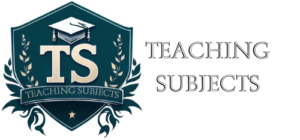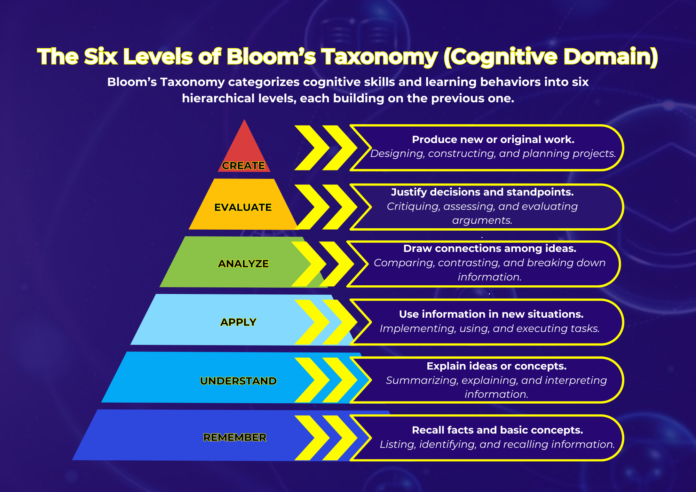Introduction
Bloom’s Taxonomy is a hierarchical model used to classify educational learning objectives into levels of complexity and specificity. Developed in the 1950s by educational psychologist Benjamin Bloom and his colleagues, this framework promotes higher forms of thinking in education, such as analyzing and evaluating concepts, processes, procedures, and principles rather than just remembering facts. Bloom’s Taxonomy remains a cornerstone in education due to its relevance in designing curriculum, formulating educational goals, and assessing student performance. Its structured approach helps educators create more effective and targeted instructional strategies, ultimately fostering deeper Understanding and mastery of subject matter among students.
What Is Bloom’s Taxonomy?
Bloom’s Taxonomy is structured into three primary domains: cognitive, affective, and psychomotor. The cognitive domain is the most commonly utilized, focusing on intellectual capabilities and knowledge acquisition. It consists of six levels, arranged in order of increasing complexity: Remembering, Understanding, Applying, Analyzing, Evaluating, and Creating. This hierarchy helps educators design learning activities that progressively build on students’ Understanding and abilities, moving from basic recall of facts to higher-order thinking skills such as critical analysis and creative problem-solving. The cognitive domain’s structure serves as a guide for both teaching and assessing, ensuring that educational objectives are comprehensive and balanced.
The affective domain addresses the emotional aspects of learning, such as attitudes, values, and feelings. It progresses from basic awareness and response to more complex internalization and consistent behavior patterns, encompassing levels like Receiving, Responding, Valuing, Organizing, and Characterizing. Although less emphasized than the cognitive domain, the affective domain shapes students’ motivation, engagement, and attitudes toward learning. While not originally included in Bloom’s foundational framework, the psychomotor domain pertains to physical skills and motor activities. Its relevance varies depending on the discipline, but it is often crucial in fields that require precise physical actions, such as physical education, performing arts, and certain sciences. However, in higher education, the cognitive domain remains paramount as it directly correlates to the critical thinking and analytical skills necessary for academic and professional success.
The Six Levels of Bloom’s Taxonomy (Cognitive Domain)
Remembering
- Definition: Recall facts and basic concepts.
- Examples: Listing, identifying, and recalling information.
- Benefits: Foundation for deeper Understanding.
Understanding
- Definition: Explain ideas or concepts.
- Examples: Summarizing, explaining, and interpreting information.
- Benefits: Enhances comprehension and retention.
Applying
- Definition: Use information in new situations.
- Examples: Implementing, using, and executing tasks.
- Benefits: Develop practical skills and problem-solving abilities.
Analyzing
- Definition: Draw connections among ideas.
- Examples: Comparing, contrasting, and breaking down information.
- Benefits: Critical thinking and deep analysis.
Evaluating
- Definition: Justify decisions and standpoints.
- Examples: Critiquing, assessing, and evaluating arguments.
- Benefits: Refines judgment and decision-making skills.
Creating
- Definition: Produce new or original work.
- Examples: Designing, constructing, and planning projects.
- Benefits: Encourages innovation and creativity.
How to Use Bloom’s Taxonomy as a College Student
Strategies for Incorporating Bloom’s Levels into Study Habits
One effective strategy for incorporating Bloom’s levels into study habits is progressively structuring study sessions to align with the hierarchy of cognitive skills. Begin with foundational activities, such as flashcards or mnemonic devices for Remembering that improve memory retention. Next, transition to activities that enhance Understanding, such as summarizing key concepts in your own words or discussing them with peers. To Apply, try solving new problems or case studies that require using learned concepts. Gradually move towards Analyzing by comparing theories or frameworks and breaking down complex ideas. Evaluating can be practiced by critiquing articles, debates, or peer work. Finally, foster creativity by engaging in projects that involve original thinking, like designing experiments, creating presentations, or developing research proposals.
Setting Learning Objectives Using Bloom’s Framework
When setting learning objectives using Bloom’s framework, it’s crucial to outline clear, measurable goals across the different cognitive skill levels. Start by identifying what knowledge you need to Remember, such as key terms, dates, or theories. Set progressively more challenging goals for understanding these concepts, such as explaining them clearly or linking them to real-world examples. Incorporate objectives for Applying knowledge through practical exercises or assignments that use the studied material. Set targets for Analyzing by planning activities that involve comparisons, categorizations, or identifying underlying principles. Define evaluation criteria for your work, focusing on key aspects to Assess. Finally, set creative goals, like devising a new solution to a problem or generating innovative ideas related to your field of study.
Creating Study Guides and Outlines Based on Different Levels
Creating study guides and outlines based on Bloom’s levels allows for a structured approach to mastering content. Begin your study guide with sections dedicated to Remembering, where you list crucial facts, terms, and definitions. Follow this with Understanding sections, including summaries of main ideas and answers to common questions. Add Applying sections that offer practice problems, case studies, and scenarios where theories are put into practice. Analyzing sections should contain comparison charts, breakdowns of complex topics, and discussion questions that delve deeper into the material. Evaluating sections can include critique questions, peer reviews, and assessments of different perspectives. Finally, Creating sections should inspire students to think beyond the given material and propose new interpretations, projects, or research endeavors. This comprehensive approach ensures that students are prepared for exams and develop a well-rounded understanding of their subjects.
Benefits of Using Bloom’s Taxonomy
Holistic Learning Approach
Adopting Bloom’s Taxonomy fosters a holistic learning approach by encouraging students to engage with material on multiple cognitive levels. By progressing through the stages—from Remembering to Creating—students build a robust understanding of subject matter that transcends rote memorization. This method ensures that learners develop essential skills such as comprehension, application, and synthesis, leading to a more integrated and comprehensive grasp of their field of study. As students move through different levels of cognitive engagement, they learn to connect various pieces of knowledge, resulting in a richer and more meaningful educational experience.
Improved Academic Performance
Implementing Bloom’s Taxonomy into study practices directly correlates with improved academic performance. By structuring their learning activities around the taxonomy’s levels, students can systematically address areas of weakness and reinforce their strengths. For instance, emphasizing Remembering and Understanding at the beginning of the study process lays a solid foundation for tackling more complex tasks such as Applying, Analyzing, and Evaluating. This structured approach enables students to master the content more, leading to better grades and a deeper appreciation of the subject matter.
Enhanced Problem-Solving and Critical Thinking Skills
One of the primary benefits of using Bloom’s Taxonomy is the enhancement of problem-solving and critical thinking skills. As students advance to higher levels of the taxonomy, they must analyze information from multiple angles and assess the validity of different arguments. This rigorous cognitive engagement fosters an environment where critical thinking can flourish, equipping students with the tools to approach complex problems logically and creatively. Through activities like critiquing, comparing, and creating, learners cultivate the ability to think deeply and innovatively, essential skills for success in both academic and professional settings.
Preparedness for Complex Real-World Challenges
A key advantage of using Bloom’s Taxonomy is its role in preparing students for complex real-world challenges. The framework’s focus on higher-order thinking skills, such as evaluating and creating, ensures that learners absorb information and learn how to apply it in practical, real-world scenarios. This preparation is crucial for navigating the multifaceted problems they will encounter in their careers and personal lives. Students develop the competencies necessary to tackle intricate issues and contribute meaningfully to their chosen fields by engaging in activities that require innovative thinking, strategic planning, and sound judgment.
Conclusion
In summary, Bloom’s Taxonomy provides a structured framework for setting learning objectives, creating study guides, and enhancing comprehension across various cognitive levels. By adopting this holistic learning approach, students can significantly improve their academic performance and develop essential problem-solving and critical-thinking skills. Moreover, incorporating Bloom’s Taxonomy prepares learners for complex real-world challenges by promoting practical application and innovative thinking. We encourage you to integrate Bloom’s Taxonomy into your daily academic practices for a more effective and enriching educational experience. Start using Bloom’s Taxonomy today to unlock your full learning potential!















